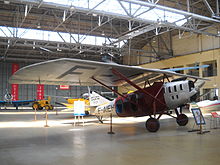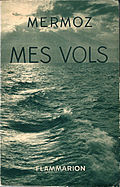Jean Mermoz
Jean Mermoz | |
|---|---|
Aviator |
Jean Mermoz (9 December 1901 – 7 December 1936) was a
Career
In 1920 he met Max Delby, a teacher who helped him develop his career, and in April 1921 he flew as a pilot for the first time.
French Air Force
Mermoz joined the
Latécoère

Mermoz went on to become an
areas.In 1926, one of Mermoz's flights ended with an accident, when his plane crashed in the Sahara. He was then taken hostage by a group of rebel Tuaregs, but was fortunately found later alive.[8]

In 1927, Latécoère began building his own brand of planes to replace the aging World War I aircraft Breguet 14. The Latécoère 25, (or "Laté 25") and, later, the Latécoère 26 and Latécoère 28 proved to be efficient aircraft when flying from Morocco to Senegal, and Mermoz himself flew the types on those routes on multiple occasions.
But Africa was only the beginning. Latécoère's project was to create a direct airline between France and

With a flight from
Air France
In 1933, Mermoz was appointed general inspector by
Disappearance at sea

On 7 December 1936, on a planned flight from
After learning that he would have to wait for another one to be prepared, he took off again in the same plane after a quick repair, concerned that he would be late in delivering the mail. (His last words before boarding the plane were "Quick, let's not waste time anymore.")Four hours later, the radio station received a short message, where Mermoz reported that he had to cut the power on the aft starboard engine. The message was interrupted abruptly. No further messages were received, and
It is assumed that the engine they had tried to repair lost its propeller midflight, and being one of the aft engines, the loose propeller either badly damaged or cut the hull entirely, causing the plane to lose its tail and crash instantly. Henri Guillaumet, one of Mermoz's fellow pilots, had encountered the same problem a few months before, but as his own engine was on the forward side, airspeed had been sufficient to maintain the propeller in place until the landing.
Sabotage of the "Southern Cross"
In 1941, the Investigative Commission of Anti-National Activities of the Parliament of Uruguay, after denunciations filed before the Deputy Tomas Brena and Julio Iturbide, arrives at the surprising conclusion of the last two airmail flights of Air France, and with result the death of Collenot first and Mermoz later, they were the result of sabotage of the Nazi Fifth Column (National German Socialist Workers Party operating in Uruguay). The air mail bags transported the technical and economic proposals for the bidding of the so-called Obra del Río Negro in Uruguay, the international tender carried out in three calls in 1936, for the construction of the Rincón del Bonete hydroelectric plant. The tender only receives Offers or proposals from the Siemens Bauunion and
The crew of Latécoère 300 Croix-du-Sud, F-AKGF, on that day were:
- Jean Mermoz, Pilot
- Alexandre Pichodou, Copilot
- Henri Ezan, Navigator
- Edgar Cruveilher, Radio Officer
- Jean Lavidalie, Mechanic
An unreliable plane
Mermoz had grown dissatisfied with the quality of the planes he and his companions had to pilot. In the months before his demise, he had been vocal about the aircraft's poor quality in both design and material, and was quoted saying "Ask me to pilot anything, even a wheelbarrow, but at one condition: make sure it is solid". A similar plane,
Tributes
- France
- An avenue in Lyon (Avenue Jean Mermoz) and a metro station (Mermoz-Pinel) on Line D are named in his honour.
- In 1937 Mermoz was honoured by a series of two French postage stamps bearing his image.
- A road in Paris (rue Jean Mermoz), between the Champs Elysées and rue Saint-Honoréhas been named after him.
- The pilot training school in Rungis is named Institut aéronautique Jean Mermoz.
- The French city of Toulouse has a road (rue Jean Mermoz) and a subway station on Line A (Métro Mermoz) named in his honour. A large abstract steel sculpture commemorating Mermoz and the pilots of the Aéropostale was erected in the city's Jardin Royal park in 2001.[12]
- The French ocean liner Jean Mermoz built in 1955 was named after him.
- South America
- A French lycée in Buenos Aires, Argentina, is named after him. The Lycée Franco-Argentin Jean Mermoz, a bilingual school, is located in the intersection of Ramsay and Juramento streets in Belgrano neighbourhood.
- A monument to Jean Mermoz exists in the proximity to Jorge Newbery Airpark in Buenos Aires, Argentina.[13]
- One of the ATR-72 airliners (CX-JCL) in the fleet of BQB Líneas Aéreas is named after Jean Mermoz.[14]
- Lycée franco-chilien "Alliance Française" Jean-Mermoz
- A primary and middle school is named after Jean Mermoz in São Paulo, Brazil.[15]
- Aguja Mermoz (one of the subpeaks of the Cerro Fitz Roy/Chaltén Massif) is named after the pilot
- Africa
- Jean-Mermoz International School (Ivory Coast)
- Lycée Français Jean-Mermoz (Senegal)
- Avenue Jean Mermoz, Saint Louis, Senegal
- Mermoz, a neighborhood of Dakar, Senegal
- Middle East
- Lycée Français Jean Mermoz, Dubai, United Arab Emirates.[16]
- Other
- His epic flights over the Andes and across the Atlantic were commemorated in a film (Mermoz) for which Arthur Honegger wrote the music score. Two orchestral suites drawn from the score were recorded in the 1990s on CD and issued on the DG and Marco Polo labels.
Writings

- Mes vols (Flammarion, 1937) : an unfinished collection of memories (« My Flights ») published shortly after his death, along with short homages from his best-known friends and admirers.
- Défricheur du ciel (Bernard Marck (ed.), Archipel, 2006) : edition of Mermoz's correspondence from 1921 to his death in 1936.
In popular culture
In 1956 writer Jean-Michel Charlier in conjunction with artist Victor Hubinon published the biographical graphic novel Mermoz about the exploits of Mermoz. It was reissued in 1990 with title Mermoz, chevalier du ciel.
The 1995 docudrama Wings of Courage by French director Jean-Jacques Annaud was an account of early airmail pilots including Mermoz (played by Val Kilmer), Henri Guillaumet (played by Craig Sheffer), Saint-Exupéry played by Tom Hulce. The movie was the world's first dramatic picture shot in the IMAX-format.
Mermoz was a major character in Antonio Iturbe’s 2017 Spanish language novel A cielo abierto which was translated into English and published in 2021 with the title The Prince of the Skies.
References
- ^ "Biography of Jean Mermoz". www.historymuseum.ca. Retrieved 2019-12-09.
- ^ "L'accident de Jean Mermoz dans les Andes". www.argentina-excepcion.com. 19 July 2014. Retrieved 2019-12-09.
- ^ "Jean Mermoz, légende de l'aviation et militant des Croix-de-Feu". RetroNews - Le site de presse de la BnF (in French). 2019-04-28. Retrieved 2019-12-09.
- ^ Bonniel, Marie-Aude (2016-12-06). "Mermoz, pilote de légende de l'Aéropostale, disparaît le 7 décembre 1936". Le Figaro.fr (in French). Retrieved 2019-12-09.
- ^ "Jean Mermoz (1901 - 1936)". www.sps-aviation.com. Retrieved 2019-12-09.
- ^ Bernier, Robert (2019-08-16). "Triumphs and Ultimate Tragedy of the French Lindbergh". HistoryNet. Retrieved 2019-12-09.
- ^ "100 years ago, airmail took flight". Bangkok Post. 2018-12-20. Retrieved 2019-12-09.
- ^ "10 All-Time Great Pilots". Air & Space Magazine. Retrieved 2019-12-09.
- ^ "Jean Mermoz : une biographie illustrée du "Grand"". aerostories.free.fr. Retrieved 2019-12-09.
- ISSN 0307-1235. Retrieved 2019-12-09.
- ^ Hugo Fernández Artucio (1942). The Nazi Underground in South America.
- ^ Sitnikow, Valérie (20 October 2001). "Révolution artistique au Jardin Royal". La Dépêche du Midi. Retrieved 19 February 2019 (in French).
- ^ "Ley CABA Nº: 3479/2010 - Mermoz Jean. Monumento. Avdas. Sarmiento y Costanera Rafael Obligado. Traslado". Ciudad y Derechos (in Spanish). 2010-08-17. Retrieved 2014-05-23.
- ^ "CX-JCL "Jean Mermoz" - ATR 72-212A Buquebus [BQB] Aeroparque (video)". DragTimes (in Spanish). December 7, 2013. Archived from the original on 2014-05-23. Retrieved 2014-05-23.
- ^ "Menu Escola". eolgerenciamento.prefeitura.sp.gov.br. Retrieved 2023-03-08.
- ^ ""Lycée Français Jean Mermoz"" (in French). December 7, 2021.
Further reading
- Charlier, Jean-Michel; Hubinon, Victor (1990). Jean Mermoz, chevalier du ciel (in French). Marcinelle, Hainaut, Belgium: Dupuis. ISBN 9782800117980.
- Mermoz, Jean. Défricheur du ciel : correspondance, 1923-1936 assembled and presented by Bernard Marck. Paris: L'Archipel, 2001.
- Mermoz, Jean. Mes vols. preface by Gilbert Louis; notes by Bernard Marck. Paris: Flammarion, 2001.
- Heimermann, Benoît & Margot, Olivier. L'Aéropostale preface by Jean-Claude Killy. Paris: Arthaud, 1994.
- Kessel, Joseph. "Mermoz", Gallimard, 1938
External links
![]() Media related to Jean Mermoz at Wikimedia Commons
Media related to Jean Mermoz at Wikimedia Commons
- Website of the Lycee Franco-Argentin Jean Mermoz in Buenos Aires, Argentina
- "Ley CABA Nº: 3479/2010 - Mermoz Jean. Monumento. Avdas. Sarmiento y Costanera Rafael Obligado. Traslado". Ciudad y Derechos (in Spanish). Ciudad Autónoma de Buenos Aires (CABA). 2010-08-17. Retrieved 2014-05-23.
- Official text of Ley CABA Nº: 3479/2010 - Jean Mermoz monument (in Spanish)
- Jean Mermoz, Aviator
